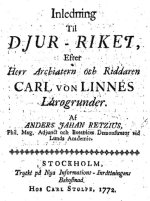As I noted above (post #147), both
Scolopax undulata Boddaert 1783 and
S. paludosa Gmelin 1789 have the bird illustrated on
Planche Enluminée 895 as their type, hence they are
objective, not subjective synonyms. As a consequence,
Xylocota Bonaparte 1839 and
Homoptilura Gray 1840 are
objective synonyms too.
As Mark noted above (post #145), Anders Jåhan Retzius also used "
Scolopax paludosa" for a Swedish bird, in an 1800 re-edition of Linnaeus'
Fauna Svecica, associating it to a rather vague description which may indeed have been intended for Great Snipe. Retzius attributed the name he was using to "Lath. Ind. 2. p. 714.", i.e. to
Latham, in Index ornithologicus, vol. 2 : 714, where the name was explicitly attributed to Gmelin. IOW, Retzius used Gmelin's name, the type of which was South American, for a Swedish species -- which can only have been an error. Although the Richmond Index has
a separate card for "
Scolopax paludosa Retzius 1800", Retzius' use of the name actually has zero nomenclatural standing under the current Code, as it was demonstrably a mere misapplication of Gmelin's name by Retzius. (I.e., it does not have the status of junior homonym; it should be cited as
Scolopax paludosa Gmelin
sensu Retzius, rather than as
S. paludosa Retzius
nec Gmelin.)
It's true that, in
Avibase, "
Scolopax paludosa" (no authority provided) is listed as a synonym of
Gallinago media -- this obviously derives from Retzius' erroneous interpretation, not from Gmelin's original name proposal, and is indeed a bit unfortunate. (On the other hand, one might probably question the wisdom of trying to use Avibase as a source of thorough scientific synonymies, as the website seems unlikely to have ever intended to fulfil this function.)
A
nomen oblitum is "a name, unused since 1899, which
as a result of an action taken under Article 23.9.2 does not take precedence over a younger synonym or homonym in prevailing usage" (
ICZN, Glossary).
Xylocota and
Homoptilura lack homonyms, and have no younger synonym in prevailing usage. (Since 1 Jan 2000 -- the date on which the current Art. 23.9.2 came into force -- they have both been universally placed in the synonymy of
Gallinago, which is older than them.) As a result, it is basically impossible that an action taken under Art. 23.9.2 might have concerned them, and these names can thus certainly NOT be
nomina oblita.
Note that being unused since 1899 (or whichever other date) does NOT make a name a
nomen oblitum. (It is the action taken under Art. 23.9.2, in a post-1999 publication, that does.)
Note also that being a
nomen oblitum does NOT necessarily make a name invalid. ("In the case of subjective synonymy [between the two names concerned by the action taken under
Art. 23.9.2], whenever the names are not regarded as synonyms the older name [= the
nomen oblitum] may be used as valid.")








